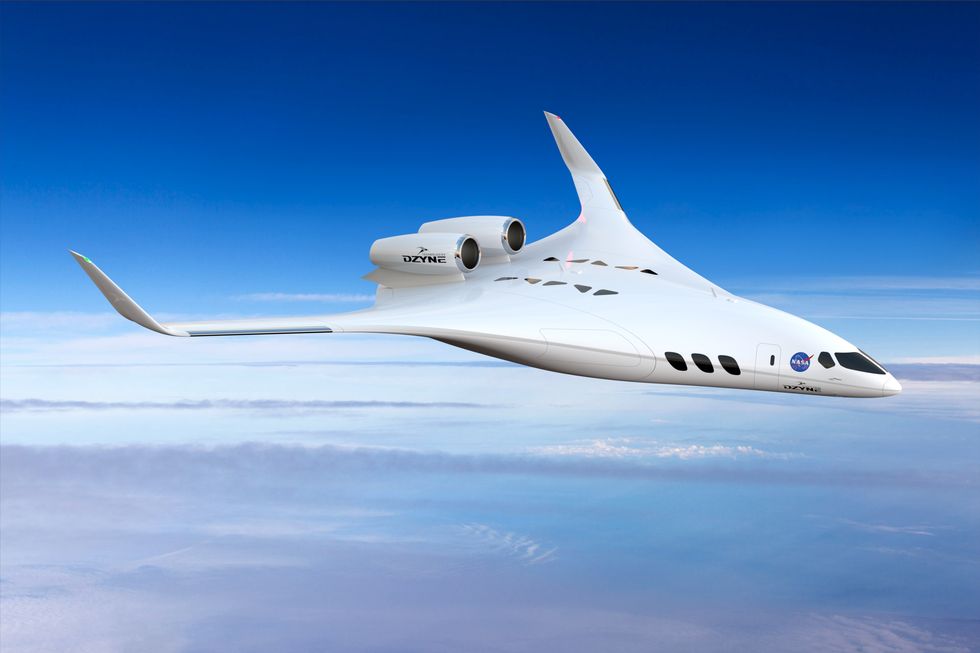-
A blended wing body aircraft could refuel military aircraft, but also spill over into the commercial airline sector.

The Air Force, according to Aviation Week & Space Technology, is expected to issue a Request for Information (RFI) from industry for a scale prototype of a blended wing body aircraft, which could make for an aircraft capable of hauling huge cargo or fuel loads with greater range and fuel efficiency than ever before.
The Air Force and Department of Defense will spend $56.9 million on an initial design study, with an emphasis on nailing down expected fuel savings if the design is adopted for tanker and transport use. AvWeek reports a more efficient tanker could not only cut the service’s annual $2 billion fuel bill, but also allow a tanker to support more aircraft over greater distances.
Traditional large aircraft typically consist of a tubular fuselage with flattened wings on both sides, and turbofan engines hanging off the wings. The blended wing body design basically looks like a traditional tube and wing aircraft if the plane were made out of unfired clay and someone stepped on it, smushing the fuselage and wing into a single, thick body. The result is a plane that, at least in concept art, often looks like a cross between a wide-bodied passenger jet and the B-2A Spirit stealth bomber.
The blended wing body design has been around since the 1990s, but never really took off. The commercial aviation industry has been content developing tube and wing aircraft, a tried and true configuration. The military, mostly for cost reasons, has piggybacked off that to field the P-8 Poseidon maritime patrol aircraft (based on the Boeing 737NG), the KC-46A Pegasus aerial refueling tanker (Boeing 767 jetliner), and the E-8C JSTARS battlefield surveillance aircraft (Boeing 707).
The blended wing body has benefits over tube and wing. Blended wing creates one large, continuous wing that helps lift and minimizes drag, resulting in the need for less fuel. It also creates a huge internal cargo space that can fit all types of military cargoes, from vehicles to supplies. It can also carry a lot of aviation fuel, both to power the aircraft and contribute to a longer operating range but also dispense the fuel to other aircraft. This would be a big plus in helping Air Force and Navy warplanes bridge the distance between North America and Asia, and the Pacific Ocean in-between.
A new aircraft design would require extensive testing to determine it is safe enough for commercial use. Once developed, airports around the world would also require upgrades, much as they did for the Airbus 380 jetliner, to support a blended wing body. The roughly triangular configuration, for example, might require a longer passenger loading bridge to span the distance from the terminal to the aircraft boarding doors.
Both Boeing (top) and Lockheed Martin (below) have experimented with blended wing body aircraft. In 2007 Boeing’s X-48B, an 8.5 percent scale model of a full-sized aircraft, flew from Rogers Dry Lake at Edwards Air Force Base, California. The X-48B was designed to “demonstrate that the novel design can be flown as safely as current transports having a traditional fuselage, wings and tail configuration”, and was followed five years later by another model, the X-48C, incorporating design changes and more powerful engines.
In 2017 NASA unveiled concept art for Lockheed Martin’s design, the Hybrid Wing Body. Hybrid Wing Body “combines features of blending the wing into the aircraft body, yet still retaining the suggestion of a T-tailed tube-and-wing configuration.” The T-tail resembles the tail of the company’s C-5M Super Galaxy transport.
The Air Force has expressed interest in the blended wing body again and again over the years. The service has repeatedly dropped the concept in favor of a civilian design, but rising fuel prices may finally push it to act. If the fuel savings on a blended wing body aircraft are significant enough, we could finally see bat-winged Air Force jets in the skies, and just maybe at commercial airports.








